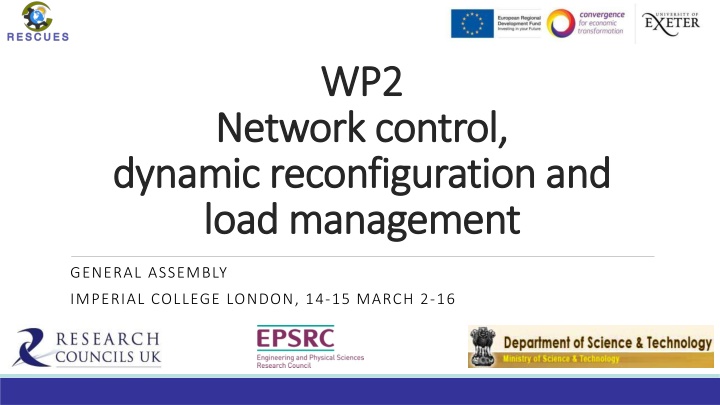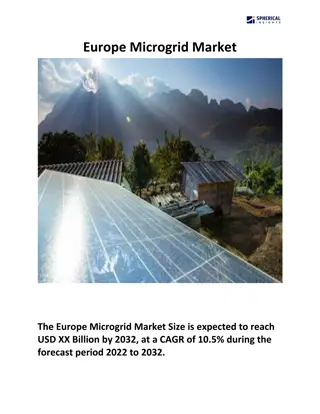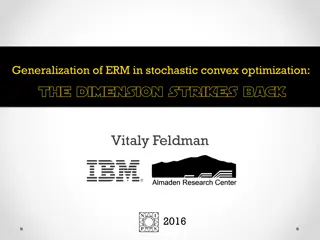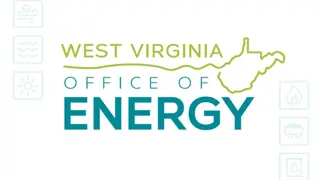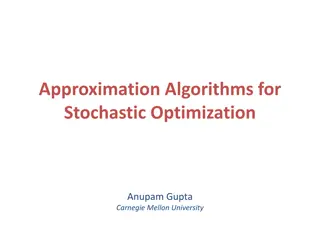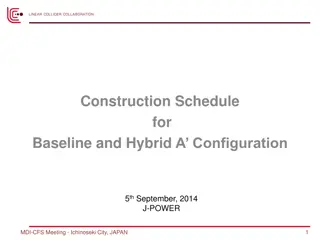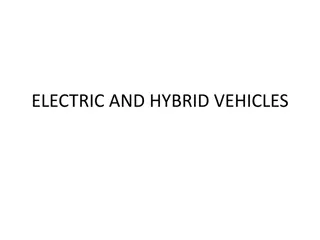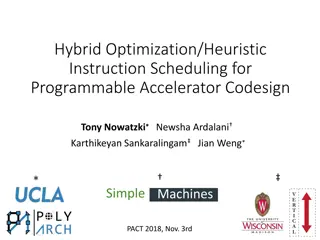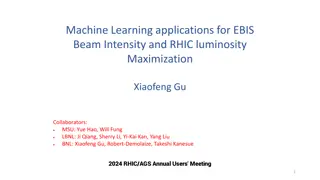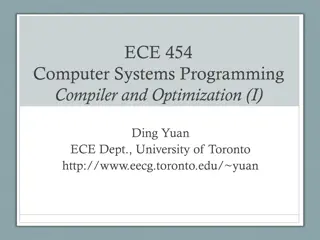Advanced Strategies for Hybrid Microgrid Optimization and Management
This project focuses on developing advanced strategies for optimization, control, dynamic reconfiguration, and load management of hybrid microgrids. Key milestones include characterizing system operations, developing optimization tools for cost-effective management, implementing schemes for stability control, and more. The work achieved so far by Imperial College London includes characterizing hybrid microgrid systems and developing optimization tools for cost-effective operation. The project aims to address challenges in operating hybrid microgrids efficiently and effectively.
Download Presentation

Please find below an Image/Link to download the presentation.
The content on the website is provided AS IS for your information and personal use only. It may not be sold, licensed, or shared on other websites without obtaining consent from the author.If you encounter any issues during the download, it is possible that the publisher has removed the file from their server.
You are allowed to download the files provided on this website for personal or commercial use, subject to the condition that they are used lawfully. All files are the property of their respective owners.
The content on the website is provided AS IS for your information and personal use only. It may not be sold, licensed, or shared on other websites without obtaining consent from the author.
E N D
Presentation Transcript
WP2 WP2 Network Network control, dynamic dynamic reconfiguration and reconfiguration and load load management management control, GENERAL ASSEMBLY IMPERIAL COLLEGE LONDON, 14-15 MARCH 2-16
Overview Overview Contributors: ICL, IITKGP, IITD, UoS Objective: develop advanced strategies for optimization, control, management and dynamic reconfiguration of the hybrid microgrid. Milestones envisaged: 1. Characterize hybrid microgrid system operation (identify issues and associated effects) 2. Develop optimization tools for cost-effective operation and management of resources 3. Develop optimization-based schemes for voltage and frequency stability control in operation 4. Implement reconfiguration and load management state estimation-based management for on-grid/off-grid dynamic
Milestones achieved so far by ICL Milestones achieved so far by ICL 1. Characterize hybrid microgrid system operation (identify issues and associated effects) ! (partly) We are referring to and characterizing a general and realistic hybrid microgrid architecture, suited to represent different contexts and energy users areas (coastal areas, remote urban/rural communities, etc.) We are considering a wide range of energy resources (DG, ES, RES), load profiles and demand requirements Still missing is the characterization of the RESCUES prototype (only AC system identified) we are waiting specs from WP1 An important problem is the lack of established standards for the DC feeder s voltage
Milestones achieved so far by ICL Milestones achieved so far by ICL 2. Develop management of resources optimization tools for (completed) cost-effective operation and We have developed a practical economic dispatch (ED) tool, suitable for integration into the energy management system and robust to uncertainties in the system We have demonstrated the robustness and efficiency of this tool by simulations on a general hybrid microgrid architecture We have demonstrated its applicability in different operating scenarios, also considering contingencies This work has produced an IEEE Transaction journal paper
Optimization Optimization tools for cost operation and management of resources operation and management of resources tools for cost- -effective effective Economic Dispatch tool Hybrid microgrid case study ????(???????) = ? ?????,?,???,?, ???,?, ???,?,?, ???,?,?= ? ? ???? ???,?+ ???? ???,?,?+ ???? ???,?,?= ? ? (? ? ???,?,?) + (? ? ???,?,?) Subject to Power Balance equations Operating limits of controllable generating unit Operating constraints of battery storage Power transfer limits for interlinking converter Contracted bands of load management on thermal loads Contracted bands of load management on electric vehicles charging ????????,?+ ??????,?+ ? ? ???? ?????,?+ ??????,?+ (? ?? ???,?) + ? ?
Some results (case A: normal conditions) Some results (case A: normal conditions) Optimal operating conditions of the hybrid MG resources in case A
Some results Some results (absence of battery storage) (absence of battery storage) Increased curtailment of controllable AC loads, particularly during daytime Curtailment similar to that of Case A for controllable DC loads. Interlinking converter forced to transfer more power from AC sub-MG to DC sub-MG
Some results (loss of one controllable generator) Some results (loss of one controllable generator) Increased curtailment of AC & DC loads, especially in daytime about 50% curtailment of scheduling at all times for EVs Interlinking converter s AC-DC power transfer reduced (up to 50%) compared to Case A Free battery storage space generally higher until early night (20:00- 02:00).
Operational costing Operational costing Alignment between economic and technical outcomes, as higher costs are seen in the most operating scenarios: Reduced controllable generation s capacity (Case B) Battery storage not included in energy management (Case C) Reduced EV controllability (Case E) inconvenient
Key aspects we have to consider in the study Key aspects we have to consider in the study of hybrid of hybrid microgrids microgrids for remote installation for remote installation In remote areas, microgrids (simple AC/DC or hybrid AC-DC) are especially interesting and convenient as stand-alone systems (disconnected from main distribution grid) Typical stand-alone applications, already existing, are insular microgrids (UK, Japan, Greece, Portugal, Turkey) Insular microgrid (FiNEST): renewable-powered, stand-alone microgrid integrated with various energy storage technologies and devices main benefit is the ability to reliably and continually produce electricity on site using local resources (solar, wind, water stream and bio-mass) supply the specific demand needs with both reduced environmental impact and improved economic efficiency reduce or eliminate the need to build traditional utility infrastructure
Key aspects we have to consider in the study Key aspects we have to consider in the study of hybrid of hybrid microgrids microgrids for remote installation for remote installation Stand-alone microgrids benefit of load management schemes alongside energy storage. So it is important to consider embedding these features into the energy management system, not only for schedule compliance but also for power balance management and thus voltage and frequency stability The characterization of a hybrid microgrid mostly relies on the DC side characterization. This is why the specs of the DC side are so important for RESCUES objectives The characterization of the DC side also depends on the on-grid or stand-alone option.
Next Next milestone milestone for for ICL ICL Develop optimization-based scheme for voltage stability control in operation of stand-alone AC-DC microgrid for remote installation. Our first objective is to develop a practical methodology and practical computational tools for a system such as the hybrid AC-DC microgrid, the characteristics, aspects and challenges of which are still not completely evaluated and defined.
Two Two- -step voltage stability management and voltage stability management and optimization of operation in optimization of operation in remote AC/DC AC/DC microgrids microgrids step methodology methodology to combine to combine remote
Methodological Methodological framework framework We will consider first static voltage stability Static voltage stability is the basic issue for energy management. Dynamic voltage stability and frequency control have to be considered separately, and they will be in future work. We will investigate the relation between voltage stability and the isolated steady-state nature of the microgrid, which determines an intrinsic weakness of the reference bus: Voltage instability can especially arise when relevant energy corridors or areas of the system are subject to high variations of load or generation - even jumps, e.g. due to RES or to load management operations.
Methodology proposal Methodology proposal Preliminary study: 1. We will start from the microgrid characterization (structure - energy resources and power loads, logic configuration, technologies, service and production mission, operation program and detailed scheduling, O&M time scenarios) 2. We will develop realistic operative scenarios for voltage stability studies 3. We will define power regulation and compensation tools 4. We will define capacity and performance limits of resources
Methodology proposal Methodology proposal Aim: integrate steady state voltage stability management and optimization tasks in the Energy Management System The optimization will address typical problems related to voltage stability (e.g., min. of power losses, min. of reactive power flows, reactive power compensation) We will consider steady-state voltage stability first We will consider voltage stability management associated with dispatch of battery storage and control of interlinking converter. The envisaged methodology is two-step, combining: load flow (LF) based voltage stability analysis (step 1) optimal power flow (OPF) assessment (step 2)
Methodology Methodology Step 1: Load Flow based (LF) method for voltage stability scenarios and index characterization Aim: Identify the points of voltage collapse ( criticalpoints on PV curves) for all microgrid s buses, and thus the weakest buses within AC and DC sub-systems. The collapse point can be used as a voltage stability index (VSI) to assess the level of voltage stability in the system. The VSI index is the means we will use to control the voltage stability in the optimization process.
Methodology Methodology Step 2: VSI-constrained optimal power flow for optimal microgrid operation and voltage stability control Traditional OPF formulation for power losses minimization Characterization and control of voltage stability through VSI constraint, in the OPF Use of battery storage dispatch and interlinking converter control for voltage stability improvement
Further step: dynamic voltage stability Further step: dynamic voltage stability Voltage instability is well-established as a dynamic phenomenon. Further, there are aspects of the problem which cannot be predicted by static load flow calculations. In the dynamics of voltage collapse, an important component is load modeling The usual load models are of two types. Most researchers use the nonlinear static models where real and reactive power are expressed as functions of voltage. Proposal (to be investigated): generalize the static load model to a dynamical one. Focus on dynamic load with exponential recovery model
Typical hybrid AC Typical hybrid AC- -DC DC microgrid microgrid system system Stand-alone microgrid representing typical installations for isolated small urban centers (about 5.000-8.000 inhabitants 30-50 MW installed power).
Composition Composition of of the the AC AC- -DC DC microgrid microgrid THESE COMPOSITION AND CONFIGURATION ARE TAILORED TO VOLTAGE STABILITY STUDIES. AC sub-system: 2 wind power plants (buses 4, 10), 1 thermal generation (bus 12), battery storage (bus 1), critical (buses 11, 12) and controllable (buses 2, 3, 5, 6, 7, 8, 9) AC loads . Loads represent an industrial district (15 MW) and a railway-electric traction substation (6 MW). Such loads are critical to voltage stability for their demand variability, which is maximum in relation to their respective scheduled on/off operation. DC sub-system: photovoltaics (bus 19), 1 EV charging station (bus 20), critical (buses 18, 21) and controllable (buses 13-18) DC loads . The EV station can serve for dispatchability of the PV plant, especially when the AC bus calls for support to voltage stability. Loads represent residential DC minigrids, industrial small factories, data centre systems, public lighting provided with LED lamps.
